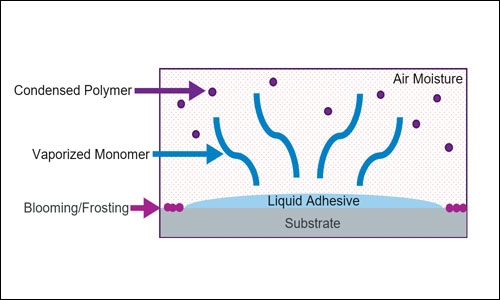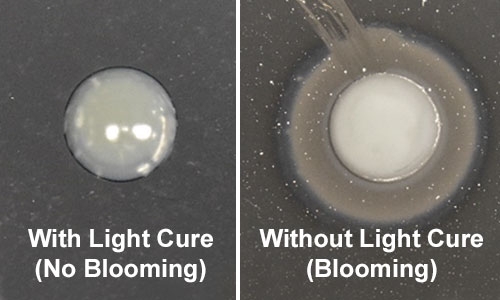CA 和 UVCA 出现白斑的原因及预防方法
快干胶(CA) 和UV固化快干胶(UVCA) 因其快速固化能力和出色的粘接强度而广受欢迎。然而,它们在使用过程中会遇到一些挑战,包括萎黄病。
什么是叶绿素缺乏症?
叶绿素缺乏症(俗称起霜或结霜)是快干胶酯单体挥发并与空气中的水分相互作用的直接结果。一旦单体蒸发并与空气中的水分相互作用,它就会变成更重的浓缩聚合物,并以众所周知的白色、粉状或结霜状外观落回到表面。配方中的杂质或污染物(例如残留水分、灰尘颗粒或不兼容的添加剂)也会导致叶绿素缺乏症。
在UV固化快干胶中,配方中加入了光引发剂,以提供额外的固化选择。虽然利用UV固化可以在单体挥发之前锁定配方,从而显著降低出现起霜的可能性,但重要的是要考虑配方中光引发剂的影响,尤其是在未使用光引发剂的情况下。配方中光引发剂的选择可能会使材料在某些条件下容易变黄或降解。
防治叶绿素缺乏症——如何减少或防止开花
- 固化期间,让材料暴露在足够的紫外线下。使用合适的光源,优化曝光时间,避免固化过快或过慢。
- 组装前彻底评估零件,以消除潜在的污染源或不兼容性。确保基材清洁,无灰尘、颗粒或油等污染物。
- 充分准备表面清洁并去除基材上的油脂,以促进更好的粘合。如果基材表面呈酸性,则会减慢固化速度并留出更多时间进行挥发。
- 保持一致的环境控制。在固化过程中监测温度和湿度条件,以帮助最大限度地减少粘合剂成分向表面的迁移。如果这些条件太低,固化时间可能会增加,并需要额外的时间进行蒸发。如果温度和湿度过高,它们可能会加速固化过程并增加放热。
- 减少固化前组件上多余的粘合剂的量,包括潜在的“挤出”或圆角。
- 组装后不要过早封闭或包装粘合部件,特别是如果有任何需要固化的黑暗或阴影区域。
- 避免使用过期的材料,因为它的固化速度会更慢。
- 正确储存并处理原材料以保持粘合剂的完整性。
使用快干胶和光固化快干胶粘合剂时,叶绿素缺乏症可能是一个问题,会影响其外观和性能。通过了解叶绿素缺乏症的原因并实施适当的策略,例如最佳紫外线照射、表面处理和粘合面积优化,可以最大限度地降低风险并有效解决此问题。通过采取这些预防措施,用户可以确保成功应用并具有最佳粘合强度和美观性。
如果您是一名设计工程师,正在寻求一种易受萎黄病影响的传统 UVCA 的替代品,您可能会对我们的新型混合光固化(HLC) 产品感兴趣。 Dymax HLC-M-1000是一种低至无白化光固化胶粘剂,专为医疗器械胶粘剂设计。阅读更多相关信息突破性技术。
请联系 Dymax 与技术专家讨论您的具体应用。


